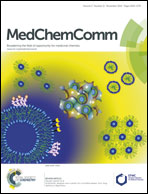Radiosynthesis and in vivo evaluation of a novel σ1 selective PET ligand†
Abstract
The σ1 receptor is an important target for CNS disorders. We previously identified a σ1 ligand TZ3108 having highly potent (Ki-σ1 = 0.48 nM) and selective affinity for σ1versus σ2 receptors. TZ3108 was 18F-labeled for in vivo evaluation. Biodistribution and blocking studies of [18F]TZ3108 in male Sprague-Dawley rats demonstrated high brain uptake, which was σ1-specific with no in vivo defluorination. MicroPET studies in cynomolgus macaques showed high brain penetration of [18F]TZ3108; the regional brain distribution was consistent with that of the σ1 receptor. Pseudo-equilibrium in the brain was reached ∼45 min post-injection. Metabolite analysis of [18F]TZ3108 in NHP blood and rodent blood and brain revealed that ∼70% parent remained in the plasma of NHPs 60 min post-injection and the major radiometabolite did not cross the blood–brain barrier in rats. In summary, the potent, selective and metabolically stable σ1 specific radioligand [18F]TZ3108 represents a potentially useful PET radioligand for quantifying the σ1 receptor in the brain.


 Please wait while we load your content...
Please wait while we load your content...